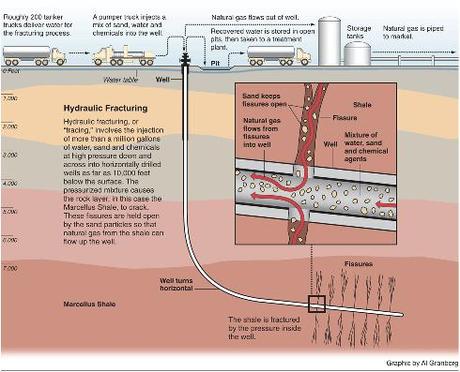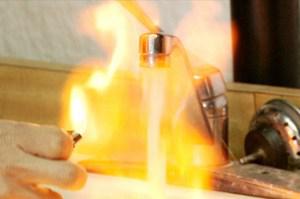This morning I woke up to some – to put it mildly – disturbing news. In the south of the Netherlands, there’s a place called Boxtel. Apparently there is shale gas present in Boxtel’s soil, and Brabant Resources B.V. which is a subsidiary of Cuadrilla Resources, plans to do some preliminary hydraulic fracturing. Hydraulic fracturing, which is more widely known as fracking, entails making minuscule fractures in the slate in which shale gas is trapped at about three or four kilometers below the ground. By doing so, the shale gas can escape and can be mined. The fractures are created by pumping water, sand and chemicals into the soil under high pressure.

Fracking: how does it work?
Why exactly do I find this news disturbing? For one, the fracking takes place near our groundwater, which is a direct link to our environment. Next to the fact that there’s a small risk of a gas leak arising and gas entering the groundwater and, inadvertently so, our drinking water, there are also the chemicals to be considered. I have heard words like polyacrylamide and glutaraldehyde. I am not a chemist by a long shot, but from what I have been able to look up polyacrylamide is a non-toxic polymer; however, the neurotoxin unpolymerized acrylamide can be present in small amounts. Glutaraldehyde can be used together with the better known formaldehyde as a fixative. Glutaraldehyde is toxic and can cause irritation to the respiratory system, headaches, dizziness and drowsiness.
Secondly, each fracking needs about 2,000,000 liters (over 50,000 gallons) of water. Since the process needs ‘clean’ water, drinking water will be used. This water will be supplied by water trucks. A quick look-up of how much water a water truck can carry, disclosed a figure of about 8,500 liters. That means that one fracking needs about 235 truckloads of water. The estimated number of necessary frackings could range from only one to a maximum of four. Four frackings means 8,000,000 liters of drinking water or 940 truckloads. Remember that we’re only talking about the preliminary drilling.
Third, this concoction of water, sand and chemicals is not supposed to disappear below the ground. Instead, it is pumped back up. Call me stupid for wondering what happens to this water next. What are they going to do with it? Are they going to dump it into the ocean? Are they going to store it some place (not so) safe? Are they going to put it on a boat and ship it off to Nigeria? Just like something cannot be made out of nothing, something cannot be made into nothing. Where will the stuff go?
Lastly, the fracking method can cause earth tremors and quakes as was proven by incidents in the British Blackpool in both April and May this year. Coincidentally, these drillings were performed by the same company Brabant Resources operates under, namely Cuadrilla Resources.
When I watched the news this morning, I remembered hearing about fracking before. This afternoon, after work, I looked it up and discovered that I had heard about a documentary called Gasland. This documentary shows numerous examples of fracking gone horribly wrong in the U.S. due to the fact that nobody seems to be taking any responsibility for the process and its often disastrous consequences. The drinking water became undrinkable and at some households even flammable. People and animals were getting health problems. Those people became incredibly frustrated since the companies and agencies involved kept saying that hydraulic fracturing was a safe method and that nothing was wrong with the drinking water. The situation becomes even more absurd when it is made known that gas companies using the method do not have to disclose the list of chemicals they are using.

From faucet to flame-thrower.
All of the above begs the question: why do we feel the need to resort to such a controversial and, for Dutch standards, unconventional method of fuel mining? Why endeavour on such a drastic operation when there could be far more environmentally friendly and sustainable alternatives? Why risk making the same mistakes and ignoring the gargantuan red flag the documentary Gasland is waving right in our faces? I am unable to come up with answers to these questions and that must mean something. Someone needs to put a stop to the preliminary drilling in Boxtel before it begins. For now, all my hopes are placed on the administrative court hearing today.
There is a petition you can sign to stop the mining of shale gas.
